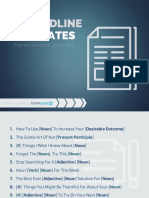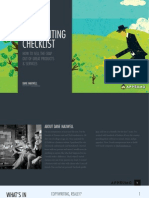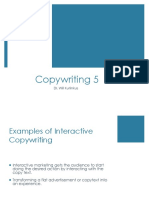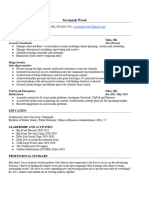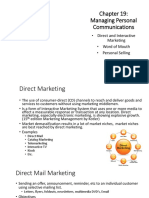Free Guide Copy Posse Glossary 31 Copywriting Marketing Terms You Need To Know
Free Guide Copy Posse Glossary 31 Copywriting Marketing Terms You Need To Know
Uploaded by
PainduCopyright:
Available Formats
Free Guide Copy Posse Glossary 31 Copywriting Marketing Terms You Need To Know
Free Guide Copy Posse Glossary 31 Copywriting Marketing Terms You Need To Know
Uploaded by
PainduOriginal Title
Copyright
Available Formats
Share this document
Did you find this document useful?
Is this content inappropriate?
Copyright:
Available Formats
Free Guide Copy Posse Glossary 31 Copywriting Marketing Terms You Need To Know
Free Guide Copy Posse Glossary 31 Copywriting Marketing Terms You Need To Know
Uploaded by
PainduCopyright:
Available Formats
C O P Y P O S S E
GLOSSARY
31 Copywriting & Marketing Terms
You Need To Know
Follow Me
© ALL RIGHTS RESERVED | COPYPOSSE.COM
COPY POSSE GLOSSARY
1. Content Marketing
Content Marketing is a holistic and strategic approach focused on consistently
creating and distributing high-quality, valuable content — across multiple
platforms and touchpoints.
Its ultimate purpose is to attract, engage, and convert a specific audience —
and drive a specific desired action… which yes, you also need those
copywriting skills for!
Content marketing is a big umbrella term that includes tons of things:
YouTube videos, social media posts, blogging, email newsletters, user-
generated content, testimonial campaigns, and much more.
2. Lead
In sales, a lead refers to a potential client or customer, regardless of whether or
not you’ve been in contact with them previously.
In digital marketing, however, the definition is a bit narrower than that. A lead
usually refers to anyone whom you have the ability and permission to follow
up with via email, phone, or direct messaging.
So they are also known as marketing-qualified leads and they are more
likely to become a customer compared to other colder leads, based on their
activity before converting. Like, say, opting into a marketing list or database.
Leads can be found anywhere and everywhere, but often they find you
through good marketing—aka lead generation.
© ALL RIGHTS RESERVED | COPYPOSSE.COM 1
COPY POSSE GLOSSARY
3. Landing Page
Speaking of lead generation. Once leads find you through ads, search engines,
or your content marketing strategies, they will often end up on a landing
page.
While a landing page is technically any page where traffic “lands,” I personally
use this term specifically for pages used for the purpose of converting visitors
into leads.
This is often done by providing a valuable FREE asset—like a checklist, cheat
sheet, or guide in exchange for their contact information (aka email address!)
4. Lead Nurturing
Once you’ve actually gotten a prospect to give you their email address or
other contact info. You begin the process of nurturing these leads—in essence,
relationship-building through providing valuable, relevant content delivered
through a series of touchpoints.
Oftentimes lead nurturing is done through email automation—like an
indoctrination sequence.
5. Marketing Funnel
Now the entire process I just described above, is part of what’s called a
marketing funnel—the entire marketing campaign and systems used to
attract visitors, convert them into leads, and nurture them towards making a
buying decision.
© ALL RIGHTS RESERVED | COPYPOSSE.COM 2
COPY POSSE GLOSSARY
6. Top of the Funnel
Within the marketing funnel, there are different stages—or levels—that a lead
will progress through on their buying journey.
The top of the funnel is the very beginning where prospects are just starting
to look for more information, identify the problem they have, and learn
about potential solutions.
So think about the very first step or touchpoint you have with a potential
customer. That is the top of the funnel where the primary objective is to build
AWARENESS. This could be, say an ad and subsequent landing page.
The copywriting at this point of the funnel needs to educate, build trust and
create authority because you’re speaking to a more unaware audience here
who really has no idea who you are or what you do.
7. Middle of the Funnel
Once the prospect has moved through the top of the funnel, by say, signing
up for your email list, they fall down to the middle of the funnel—where they’re
now more aware of the problem they have and how you can help solve it.
This is where your copy will be to be focused heavily on storytelling,
reliability, and empathy. The main objective here is to build INTEREST and
DESIRE. This is where you want to specify pain points, features & benefits…
And convince your prospect that YOUR solution is what they’re seeking.
© ALL RIGHTS RESERVED | COPYPOSSE.COM 3
COPY POSSE GLOSSARY
8. Bottom of the Funnel
As your prospect consumes your content and continues to engage with your
brand, they fall down to the bottom of the funnel or (hopefully) the final stage
of the buying journey, where they have connected with you and your solution
and are close to making a purchase decision.
The objective here is to get them to take ACTION and buy!
So you want to highlight more social proof, lower perceived risk, overcome
objections and of course, make an irresistible offer.
9. Case Study
A case study is a public analysis of the work a company did for a customer
that highlights the goals, processes, and results the customer achieved. So
think of it as an in-depth testimonial or review that involves an interview and
analysis of a company’s product or service.
Case studies are great ways to build trust and authority by showcasing
tangible results. So for example, as a bonus in my Write & Ignite Challenge, I
interviewed one of my past students for a case study on how she has used my
process and formulas to ignite a full-time copywriting career.
Learn more about my Write and Ignite Challenge and get your hands on that
case study and lots more juicy training by following the link above.
© ALL RIGHTS RESERVED | COPYPOSSE.COM 4
COPY POSSE GLOSSARY
10. A/B Testing
Also referred to as split testing, A/B testing is the process of testing two
variations of a specific element on a marketing asset, while keeping
everything else the same, to determine which version creates a better long-
term result.
A/B testing can massively boost the long-term profitability and conversions of
a marketing campaign. You can split test literally everything from subject
lines and headlines to page layout and button colors!
11. Bounce Rate
Bounce rate is the percentage of visitors who click out or close a site after
viewing only one page. In other words, they didn’t find what they were looking
for and didn’t feel compelled to stick around or navigate to learn more.
12. Click-Through Rate (CTR)
Click-Through Rate is the percentage of people who view and, ultimately, click
on a link or button.
That could be a link in an email that drives traffic to your site or newest
YouTube video… a link on a Facebook Ad that leads to a landing page, or any
other link that you are using in your marketing funnel.
The higher the CTR at each step of your funnel, the better your marketing will
perform overall.
© ALL RIGHTS RESERVED | COPYPOSSE.COM 5
COPY POSSE GLOSSARY
13. Call to Action (CTA)
A Call to Action is the specific, desired, action that you want your prospects to
take. So maybe that’s to sign up for a mailing list, buy your product, sign up for
a free call, click a link, or leave a comment...
Just remember, that no matter what action you want your prospects to take,
you need to clearly tell them what that is!
And you should only have one clear and concise CTA per step of the
marketing funnel. Remember: confusion is the biggest conversion killer!
14. Conversion Rate
Maybe the most common metric referred to in marketing is conversion rate—
the percentage of users who actually follow through on your CTA and take the
desired action.
A Conversion can mean anything, depending on your CTA, but most often is
referred to in terms of leads or sales.
15. Return on Investment (ROI)
After you know your conversion rate, you’ll be able to figure out your ROI—or
Return On Investment—a ratio that evaluates the profitability of a marketing
effort by measuring the revenue compared to cost.
When it comes to ROI, the higher the better, obviously. A high ROI means that
you’ve gained more than you’ve lost.
© ALL RIGHTS RESERVED | COPYPOSSE.COM 6
COPY POSSE GLOSSARY
16. Keyword Research
Firstly, a keyword is a specific word or phrase that a prospect might type into a
search engine when looking for products, services, or general information.
Keyword research is when you research what those search terms are—often
using keyword research tools—so that you can include those keywords in your
content and marketing to better target your customer avatar.
17. Search Engine Optimization (SEO)
This is different from keyword research. SEO, or Search Engine Optimization, is
the act of increasing a website’s visibility in organic, unpaid, search results.
Typically done through SEO techniques like generating backlinks,
incorporating relevant keywords, and publishing authoritative and consistent
content.
SEO involves so much more than keyword research, so be careful not to use
these terms interchangeably or you may end up agreeing to way more than
you can confidently deliver on.
18. Unique Selling Proposition (USP)
A USP is what makes a brand, product, or service different from its
competitors... Think of it as the competitive edge you hold over your
competition. A USP is short and simple… but effective.
In a single sentence you should be able to effectively communicate why your
company, product, or service is superior to others… and thus WHY someone
should buy from you and not Sally over there.
© ALL RIGHTS RESERVED | COPYPOSSE.COM 7
COPY POSSE GLOSSARY
19. One Time Offer (OTO)
This refers to a sales page that promotes a special offer that is available… yep,
you guessed it… for one time only.
A one time offer is something that TRULY expires when you say it will. And it’s
often presented immediately after an email signup, or registration of some
sort. Like when you subscribe to the email list of your fave online store and
then get a 10% discount code!
People LOVE discounts and good deals. In fact, approximately 34% of
Millennials look for online coupons on a weekly basis. The caveat to using
OTOs is that they only work if you actually pull the offer when you say you’re
going to!
20. Customer Lifetime Value (CLV)
This is the total amount of money a customer is expected to spend on your
products/services during their lifetime as a customer with you. And obviously,
the longer you keep a customer, the greater your CLV will be.
To truly keep your customers long-term, you have to go above and beyond. So
that means having stellar customer support like:
Resolving their issues
Answering their concerns
Delivering to them on time
Making them feel a part of the community
A staggering 70% of people will support a company that delivers great
customer service, and on the other side of the coin… the average American will
tell 15 people when they’ve had a bad customer experience.
© ALL RIGHTS RESERVED | COPYPOSSE.COM 8
COPY POSSE GLOSSARY
21. Word of Mouth (WOM)
Word of mouth is a marketing method that relies on organic social
interactions and conversations to promote a product or service.
People are 90% more likely to trust and buy from a brand that was
recommended by a friend. And the real mind-blower here... word of mouth
impressions result in 5x more sales than a paid media impression.
22. Conversion Rate Optimization (CRO)
Conversion Rate Optimization is “a system for increasing the percentage of
visitors to a website that converts into customers" or more generally, takes any
desired action on a webpage. This can be done in a number of different ways:
Increasing customer value proposition
Improving site speed
Utilizing scarcity principles
Employing A/B Testing
While yes, running split testing IS an extra step... the payoff is well worth it.
Companies that A/B test every email see email marketing returns that are 37%
higher than those of brands that never include A/B tests.
23. Awareness, Interest, Desire, Action (AIDA)
Thought of as one of the best-known marketing models out there, AIDA is a
hierarchical marketing model that represents the stages a consumer passes
through when making purchasing decisions.
© ALL RIGHTS RESERVED | COPYPOSSE.COM 9
COPY POSSE GLOSSARY
You can think of this model as a funnel that customers go through on their
journey to the final purchase, with awareness being at the top, and widest
part, of the funnel… and action being the bottom of the funnel.
24. Squeeze Page
A squeeze page is a SPECIFIC type of landing page solely designed to capture
email addresses from potential subscribers. Instead of focusing on promoting
a product, the intention is to “squeeze” a visitor into entering their email
address—which in direct response marketing is one of the most valuable
pieces of data you can get from a prospect.
Now, if you’re like, wait—what’s the difference between a landing page, opt-in
page, and squeeze page?
Well, let me break it down.
Landing pages are web pages that have a singular conversion focus –
usually, it’s either to sign up or buy. Landing pages are called “landing
pages” because it’s where traffic “lands” on a site – although usually not
organically. Landing pages are strategic pages often built for converting
paid traffic.
Optin pages are landing pages specifically used to get a prospect to sign
up – so it might be to get a free guide, start a free trial, or register for a
webinar. It’s a broad term that applies to any page asking for user
information, whether it be email, phone number, name, or any other sort
of data.
© ALL RIGHTS RESERVED | COPYPOSSE.COM 10
COPY POSSE GLOSSARY
Squeeze pages are a bit different. They’re a lot more limited opt-in pages
where the only obvious action is to sign-up and enter your email address.
This often means there’s no navigation or other calls-to-action that could
distract a prospect from opting in.
Think of it this way: All squeeze pages are opt-in pages. All opt-in pages are
landing pages. But it doesn’t work the other way around. Got it?
25. Upsell
Upsell refers to an add-on offer that you present to a customer after the front-
end purchase. Think of it as an upgrade that you want to offer your customers
to enhance their experience with your brand and increase the average order
value of their purchase.
An upsell can be presented immediately after a purchase, like when you
purchase a program online and then are asked to join a membership
community or sign up for an exclusive coaching package.
An upsell can also happen sometime later, after the initial front-end product
sale. For example, an airline might offer you an upgrade from economy to
business class at a reduced price when you check in for your flight.
26. Retargeting
Retargeting (also known as remarketing) is a form of advertising that targets
prospects who have previously engaged with your website or your business in
general.
© ALL RIGHTS RESERVED | COPYPOSSE.COM 11
COPY POSSE GLOSSARY
Retargeting is based on the premise that often it takes multiple touchpoints
with your brand or product to convince someone to buy. When used correctly,
these smart tactics can be highly effective.
Retargeting also allows you to use sequential and behavior-based ads in your
marketing and copywriting. So a customer might see an ad to upgrade, where
a non-customer will see a compelling offer to buy. Or, perhaps a series of ads
shown in sequential order that tell a story and help overcome objections.
27. List Segmentation
While retargeting is about marketing to a prospect or customer on the front-
end based on their interaction with a particular brand—list segmentation
happens on the back-end and refers to the grouping together of your
subscribers based on specific criteria that can help you better understand and
communicate with your audience.
This grouping can be based on demographic, geographic, or psychographic
data, survey or quiz results, email engagement, or specific actions they’ve
taken, for example, purchasing, attending a masterclass, or subscribing to a
free guide. For example, Campaign Monitor allows you to segment your
subscribers based on gender.
The more granular you get with your list segmentation, the more personalized
and effective your messaging can be. The best marketing is that which most
accurately targets its viewers.
© ALL RIGHTS RESERVED | COPYPOSSE.COM 12
COPY POSSE GLOSSARY
28. Risk Reversal
In copywriting, risk reversal is commonly a statement or guarantee that
assures your prospect that YOU will bear the risk of their purchase… through a
refund, exchange, or return policy.
Your Risk Reversal statement should make the entire purchase process sound
easy and that it’s totally ok if they decide to return or exchange your product.
For example, this is typically what Mindvalley, one of the largest personal
growth brands on the planet, uses on their sales pages:
Get 10 days risk-free to try this program. Remember, you don’t even have
to say YES right now. You only have to say MAYBE. You have 10 days after
the date of purchase to try this product and get a full refund sent to you.
29. Lead Magnet
A lead magnet is a freebie or a preview of your product or service that
incentivizes potential leads to subscribe to your email list and be part of your
community.
It’s the law of reciprocity at its finest. Sign up and in exchange, I’ll give you
something valuable for free. A lead magnet could be a free ebook, webinar,
trial period, quiz, and so much more.
© ALL RIGHTS RESERVED | COPYPOSSE.COM 13
COPY POSSE GLOSSARY
30. Indoctrination Sequence
An Indoctrination Sequence refers to the first few emails that you send to
fresh leads to let them get to know who you are, what you do, and why they
should stick around. Consider it the first step to building a relationship with
your subscribers and connecting with them on an emotional level before you
present them with an offer.
This is where you deliver your lead magnet and welcome a prospect to your
brand. Let them know what to expect as a new member of your community,
acknowledge why they are there and what you can help them with, share
your mission, then inspire them to take the next step.
For example, when you join the Copy Posse community, you’ll get 3 emails
from me.
The first email you get in your inbox welcomes you to the baddest, raddest
crew of copywriters on the internet. The second email shares my mission to
change the game of copywriting. The third email sets expectations and shares
how I can help you.
Sign up to check it out for yourself.
© ALL RIGHTS RESERVED | COPYPOSSE.COM 14
COPY POSSE GLOSSARY
31. Cart Abandonment Email
A Cart Abandonment Email is an email sent to a prospect after they left their
shopping cart before making the purchase.
Go Daddy reports that 69% of shoppers abandon their cart. A well-written
Cart Abandonment Email can recoup 30% of your lost customers, resulting in
a 64% increase in revenue.
Inside my copywriting program, I teach an entire C.A.R.T. cart abandonment
sequence framework, but even one Cart Abandonment Email can be highly
effective. The goal of this email is simple: To remind shoppers that the product
is still waiting and available for them to buy.
Many businesses rely solely on a text-based email to do this. However, there
are plenty of creative ways for you to tempt your prospects back to their cart.
For example, Reformation, a sustainable clothing brand, does this well by
sending prospects a cheeky email that reads, "Don’t play coy, we saw you
checking us out." along with a photo of the exact item left in the cart.
© ALL RIGHTS RESERVED | COPYPOSSE.COM 15
ABOUT
ALEX CATTONI
Alex is a copywriter, marketing strategist, and the founder of The Copy
Posse—a boutique agency, online academy, and now 100,000+ strong
global crew of authentic copywriters with a passion for creating
community, credibility, and conversions with nothing but powerful and
precise wording.
Her goal is to redefine what it means to be a copywriter and marketer
today and share the techniques and strategies she’s used to build a
heart-centered 7-figure business from the ground up.
Follow Alex on YouTube and Instagram
for free content and copywriting tips.
Visit AlexCattoni.com to learn more
about her work and programs.
To learn more about copywriting,
and master her proven 16-Step
Sales Page Formula and 3 special
bonuses, you can join the
Write & Ignite Challenge here.
Or click here to learn more about
Alex's flagship copywriting
coaching program:
The Copy Posse Launch Files.
Follow Me
© ALL RIGHTS RESERVED | COPYPOSSE.COM
You might also like
- Copy Posse Free Guide Customer Avatar WorksheetDocument6 pagesCopy Posse Free Guide Customer Avatar WorksheetBethel TesfahunNo ratings yet
- 03 Email FormulasDocument10 pages03 Email Formulassahil singh100% (1)
- Hot Offer Checklist: Alex Cattoni'sDocument5 pagesHot Offer Checklist: Alex Cattoni'sAyoola100% (1)
- Alex Cattoni's PresentationDocument75 pagesAlex Cattoni's PresentationEphrayim OdorNo ratings yet
- 01-Instant Subject LinesDocument74 pages01-Instant Subject LinesAsun Merdier100% (3)
- Traffic & Funnels Avatar & Niche WorksheetDocument2 pagesTraffic & Funnels Avatar & Niche WorksheetGeorgi CochevNo ratings yet
- Headlines Subheads and Value Propositions COPY HACKERS 2nd Edition For 2014Document63 pagesHeadlines Subheads and Value Propositions COPY HACKERS 2nd Edition For 2014Igor R Souza100% (2)
- Where Stellar Messages Come FromDocument10 pagesWhere Stellar Messages Come FromSam100% (1)
- Mastering Inbound Marketing: Your Complete Guide to Building a Results-Driven Inbound StrategyFrom EverandMastering Inbound Marketing: Your Complete Guide to Building a Results-Driven Inbound StrategyNo ratings yet
- The Content Marketing Playbook - Strategies to Attract the Right CustomersFrom EverandThe Content Marketing Playbook - Strategies to Attract the Right CustomersNo ratings yet
- 06-29 Posse-Approved Questions To Master Any Brand VoiceDocument3 pages06-29 Posse-Approved Questions To Master Any Brand VoiceSunil Kumar100% (1)
- Conversion Sabotaging WordsDocument16 pagesConversion Sabotaging WordsPerpetua NeoNo ratings yet
- Headline TemplatesDocument12 pagesHeadline TemplatesAnonymous XBdKkynNo ratings yet
- Effective Copywriting BlueprintDocument17 pagesEffective Copywriting BlueprintAndy ChauNo ratings yet
- 01-Week 2 SlidesDocument121 pages01-Week 2 Slidesdialm4monojoyNo ratings yet
- 01-Week 9 SlidesDocument70 pages01-Week 9 Slidesdialm4monojoy100% (1)
- Copywriting ChecklistDocument2 pagesCopywriting ChecklistChella Perumal100% (1)
- Appendix 1 - Copywriting HeadlinesDocument2 pagesAppendix 1 - Copywriting HeadlinesDebanik GhoshNo ratings yet
- Course Overview and SyllabusDocument17 pagesCourse Overview and SyllabusJoelNo ratings yet
- Copywriting Research MethodsDocument3 pagesCopywriting Research MethodsTyNo ratings yet
- Free Guide Brand Voice ChecklistDocument16 pagesFree Guide Brand Voice ChecklistJonathan JamesNo ratings yet
- Alex Cattoni Customer Avatar ExerciseDocument6 pagesAlex Cattoni Customer Avatar ExerciseHarrshitaNo ratings yet
- AppSumo The Copywriting ChecklistDocument17 pagesAppSumo The Copywriting ChecklistDuke Sayer100% (2)
- OutreachDocument2 pagesOutreachTristan TNo ratings yet
- Copy Hackers Checklist For Copy FormattingDocument1 pageCopy Hackers Checklist For Copy FormattingsteveNo ratings yet
- Email Copywriting TemplatesDocument27 pagesEmail Copywriting Templatesinfo100% (1)
- Copywriting 5: Dr. Will KurlinkusDocument17 pagesCopywriting 5: Dr. Will KurlinkusWill KurlinkusNo ratings yet
- High CTR Headline ExamplesDocument5 pagesHigh CTR Headline ExamplesMahfuzur Rahman FardunNo ratings yet
- 101 Fill-In-The-Blank Email Subject Line TemplatesDocument12 pages101 Fill-In-The-Blank Email Subject Line TemplatesKartik BediNo ratings yet
- Client QuestionsDocument4 pagesClient QuestionssherifNo ratings yet
- Bonus 4-TRS - Viral Video Intro-Outro Takeoff TemplatesDocument10 pagesBonus 4-TRS - Viral Video Intro-Outro Takeoff TemplatesBuhly Rvsf100% (1)
- Advertorial Should Tell A StoryDocument3 pagesAdvertorial Should Tell A StorySaskia LourensNo ratings yet
- 01-Week 1 SlidesDocument63 pages01-Week 1 Slidesdialm4monojoyNo ratings yet
- AIDADocument26 pagesAIDATammam Alabbas100% (1)
- 07-The Copy Posse Lead Magnet GuideDocument6 pages07-The Copy Posse Lead Magnet GuideSunil Kumar100% (2)
- 7 Figure Marketing Guide - Forgive Them Their FaultsDocument14 pages7 Figure Marketing Guide - Forgive Them Their FaultsDiálogos sobre el Aprendizaje100% (1)
- Email CopywritingDocument88 pagesEmail Copywritingjames vishdasamNo ratings yet
- SOAP Sequence Templates 2019Document4 pagesSOAP Sequence Templates 2019ff100% (1)
- Email Marketing Guide HubspotDocument9 pagesEmail Marketing Guide HubspotAuriac jofrel DiatsouikaNo ratings yet
- A-Z Copywriting Workshop - Hooks & ThemesDocument18 pagesA-Z Copywriting Workshop - Hooks & ThemesChristian Attong100% (1)
- Please Refer To The Funnel Map.: BrewedfunnelsmediaDocument18 pagesPlease Refer To The Funnel Map.: BrewedfunnelsmediaCam WilkesNo ratings yet
- HubSpot - 16 Free Sales Voicemail TemplatesDocument14 pagesHubSpot - 16 Free Sales Voicemail Templatesameya kapreNo ratings yet
- Sales Workshop Part 2Document42 pagesSales Workshop Part 2TestNo ratings yet
- Landing Pages How To Turn Traffic Into MoneyDocument49 pagesLanding Pages How To Turn Traffic Into MoneybambangokeNo ratings yet
- Avatar Empathy Map-Powerpoint-02Document1 pageAvatar Empathy Map-Powerpoint-02Edgar DelgadoNo ratings yet
- 101 Fill-In The-Blanks Email Subject Line TemplatesDocument12 pages101 Fill-In The-Blanks Email Subject Line TemplatesEmmanuel AkinwolemiwaNo ratings yet
- Email SequenceDocument5 pagesEmail SequencesimNo ratings yet
- 113 Subject Formulas CTA 2 0Document8 pages113 Subject Formulas CTA 2 0Mohamadu DickoNo ratings yet
- Successful Branding: 5 Key Elements and 1 Mantra!Document9 pagesSuccessful Branding: 5 Key Elements and 1 Mantra!killerbboyNo ratings yet
- 4D CJN Email Copywriting TemplateDocument5 pages4D CJN Email Copywriting TemplateSacchi BhattacharyyaNo ratings yet
- The 27 Copywriting Formulas That Will Drive Clicks and Engagement On Social MediaDocument9 pagesThe 27 Copywriting Formulas That Will Drive Clicks and Engagement On Social MediaJuan IsaacNo ratings yet
- Conversion Copywriting Sourcebook: Samuel J. WoodsDocument39 pagesConversion Copywriting Sourcebook: Samuel J. WoodsMomo Land100% (1)
- E-Book Increase Brand Awareness PDFDocument51 pagesE-Book Increase Brand Awareness PDFPrashanth NarayanNo ratings yet
- Dotcom Secrets FB Ads GuideDocument39 pagesDotcom Secrets FB Ads GuideRudy SimonsNo ratings yet
- Email Course Topic GeneratorDocument1 pageEmail Course Topic Generatordady nugrahaNo ratings yet
- 8 Step Process Sales PageDocument6 pages8 Step Process Sales PageVittoria DaelliNo ratings yet
- BlackFridayBootcamp2013 PDFDocument118 pagesBlackFridayBootcamp2013 PDFchrisdire849100% (1)
- 01-Week 8 SlidesDocument89 pages01-Week 8 Slidesdialm4monojoyNo ratings yet
- Digital Marketing Intro Class Lesson 1Document11 pagesDigital Marketing Intro Class Lesson 1focusinstitute84No ratings yet
- Product LabellingDocument6 pagesProduct LabellingMia Butiong100% (1)
- Retail Branding Guidance: 08 June 2022Document21 pagesRetail Branding Guidance: 08 June 2022paimo killrocknrollNo ratings yet
- Kitkat Campus DriveDocument6 pagesKitkat Campus Drivesohilbankar7No ratings yet
- AdvertisingDocument80 pagesAdvertisingRajat ChauhanNo ratings yet
- Mba 5240-Winter 2023 - Week 8 - Major Assignment 7 - Chapter 13 - 8 EssaysDocument3 pagesMba 5240-Winter 2023 - Week 8 - Major Assignment 7 - Chapter 13 - 8 EssaysWilly IsianiNo ratings yet
- Media-Planning Solved MCQs (Set-6)Document8 pagesMedia-Planning Solved MCQs (Set-6)PARTH MANJREKARNo ratings yet
- SnickersDocument15 pagesSnickersAntarleena SikdarNo ratings yet
- Back Link WatchDocument9 pagesBack Link WatchShakir MohammadNo ratings yet
- Principles of MarketingDocument3 pagesPrinciples of MarketingAbbasali SayedNo ratings yet
- IMC Session 1Document27 pagesIMC Session 1Rashi KakkarNo ratings yet
- Entrepreneurship Week 8 PDFDocument8 pagesEntrepreneurship Week 8 PDFjohnNo ratings yet
- BUS 622 Week 4 Discussion 1Document3 pagesBUS 622 Week 4 Discussion 1writer topNo ratings yet
- AdvertismentDocument5 pagesAdvertismentDesainCVKreatif.comNo ratings yet
- Likiths AnneDocument113 pagesLikiths AnneArchana J RetinueNo ratings yet
- HulDocument18 pagesHulEkta NandrayogNo ratings yet
- Brand Extension AssignmentDocument5 pagesBrand Extension AssignmentAlka Dubey100% (2)
- Cetaphil Integrated Marketing CampaignDocument19 pagesCetaphil Integrated Marketing Campaigndiksha.gandhiNo ratings yet
- Savannah Wood Resume 2024Document1 pageSavannah Wood Resume 2024api-526758993No ratings yet
- (Pr-Ex) Hoang Phuc - 1997 - 0707319989 - EngverDocument1 page(Pr-Ex) Hoang Phuc - 1997 - 0707319989 - EngverNguyễn PhúcNo ratings yet
- Camila Pérez CV MarketingDocument2 pagesCamila Pérez CV Marketingpaola leonesaNo ratings yet
- Brand Management Module 2Document17 pagesBrand Management Module 2Monsters vlogsNo ratings yet
- Marketing Management Class 12 Project On Crispy CrunchyDocument27 pagesMarketing Management Class 12 Project On Crispy Crunchysoundar rajNo ratings yet
- Marketing TriviaDocument7 pagesMarketing TriviaNURUL QISTINA BINTI KAMEL MBS221027No ratings yet
- Module 5 - Advertising Media and Evaluation of Advertising EffectivenessDocument45 pagesModule 5 - Advertising Media and Evaluation of Advertising EffectivenesskiranNo ratings yet
- BCG Matrix InfographicsDocument24 pagesBCG Matrix InfographicsVinayNo ratings yet
- Ring Chips Spicy "Document15 pagesRing Chips Spicy "Talha AhmedNo ratings yet
- Chapter 19 Managing Personal CommunicationsDocument15 pagesChapter 19 Managing Personal CommunicationsButch TuanNo ratings yet
- Billabong Building A Digital Marketing StrategyDocument2 pagesBillabong Building A Digital Marketing StrategyJYOTI MAURYANo ratings yet
- Pages From TANG1 - Reading The News 1Document9 pagesPages From TANG1 - Reading The News 1Trang NguyễnNo ratings yet














